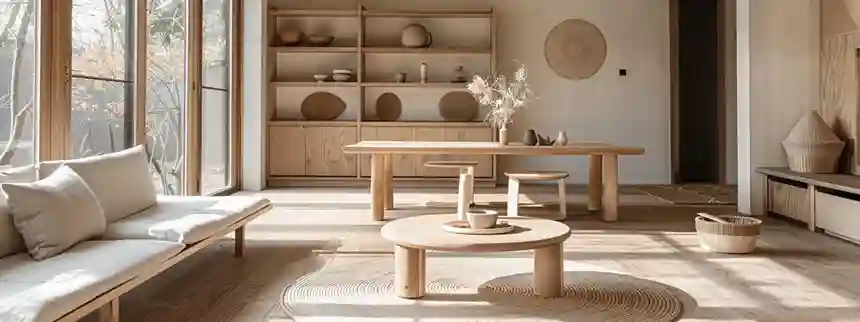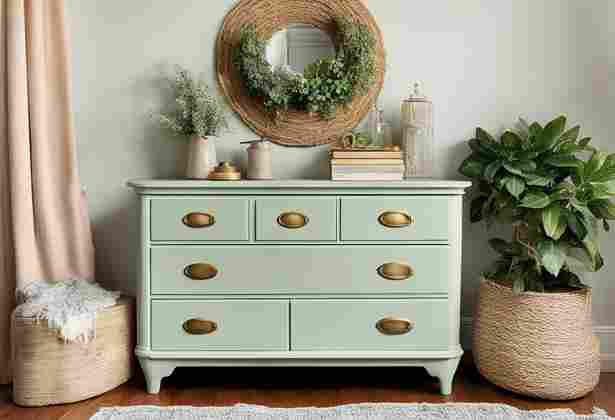Japandi Homes to Fall in Love With Instantly
In a fast-paced world where chaos often creeps into our living spaces, Japandi homes offer a breath of fresh, minimalist air. This serene design style—born from the fusion of Japanese and Scandinavian aesthetics—is quietly taking over modern U.S. interiors in 2025. Its clean lines, muted tones, and thoughtful simplicity aren’t just beautiful to look at—they’re deeply calming to live in.
So, what exactly is Japandi?
At its core, Japandi is the elegant meeting point of Japanese wabi-sabi—the beauty of imperfection and impermanence—and Scandinavian hygge, a cozy, comforting approach to everyday life. The result is a design language that prioritizes warmth, functionality, and mindfulness over clutter or trends.
More than just a style, Japandi is a lifestyle choice. It’s for anyone who wants a space that feels as good as it looks. Whether you’re revamping a small apartment or building your dream home from scratch, Japandi helps you create rooms that invite peace, simplicity, and intentional living.
In this in-depth guide, we’ll explore:
- The defining features of Japandi homes
- Room-by-room design strategies
- Common mistakes to avoid
- Budget-friendly ways to get started
- Real-life examples and expert tips
Ready to fall in love with your space all over again? Let’s dive into the world of Japandi.
Japandi Homes 101: What Defines This Hybrid Style?
At first glance, Japandi may seem like another minimalist trend—but look closer, and you’ll discover a philosophy that runs much deeper. This design fusion draws from the wabi-sabi ideals of Japan and the hygge principles of Scandinavia—two cultures separated by geography but united by a shared love of intentional simplicity and emotional comfort.
Let’s break down the essentials of what makes Japandi so distinctive—and so irresistible.
Minimalism Without the Coldness
While traditional minimalism often strips away personality in favor of stark, clinical spaces, Japandi brings warmth and soul back into the picture. It’s minimalism reimagined for real life—spaces are kept clutter-free but feel lived-in and welcoming. Every piece of furniture or decor is purposeful, but it also tells a story.
A Balance of Light and Dark Tones
Scandinavian interiors typically favor light, airy palettes to offset long, dark winters, while Japanese design leans into deeper, earthy hues. Japandi finds harmony between the two—think light oak flooring paired with charcoal linen, or cream walls offset by black-framed windows. The result is a balanced, layered space that feels grounded yet expansive.
Sustainability and Natural Materials
Japandi interiors emphasize sustainability not just as a buzzword—but as a guiding principle. Furniture is often crafted from wood, rattan, bamboo, or other renewable resources. Instead of fast decor, Japandi celebrates long-lasting craftsmanship, handmade objects, and materials that age gracefully with time. Ceramics, linen, wool, and stone are favored for their natural textures and enduring appeal.
This ethos resonates strongly with eco-conscious American homeowners who are moving away from disposable design and toward mindful consumption.
Why Japandi Works So Well in the U.S.
Americans are increasingly drawn to lifestyles that offer more calm, clarity, and control—especially in the wake of digital overload and economic uncertainty. Japandi delivers exactly that. It combines the emotional comfort of Scandinavian interiors with the intentional restraint of Japanese spaces, offering a way to live beautifully with less.
Whether you’re designing a city apartment, a suburban retreat, or a rural hideaway, Japandi adapts beautifully to American homes—especially those craving order, warmth, and sustainable living without sacrificing style.
Core Elements of Japandi Homes
What makes a space unmistakably Japandi? It’s not just the look—it’s the thoughtfulness behind every design choice. Japandi homes are built on a foundation of simplicity, warmth, and authenticity. Each element is carefully selected to serve a purpose—visually, emotionally, and functionally.
Let’s take a closer look at the key components that define a true Japandi interior:
Natural Materials and Earthy Tones
Japandi homes are rooted in nature—both in form and feeling. The use of organic, sustainable materials is essential to achieving this grounded aesthetic.
- Wood is the most prominent material—light oak or birch from Scandinavian influence, and darker walnut or bamboo from Japanese design.
- Stone, linen, rattan, and clay add layers of texture and reinforce the earthy, tactile quality of the space.
- The color palette avoids anything artificial or loud, instead embracing muted tones like:
- Sand
- Taupe
- Charcoal
- Sage
- Muted ivory or soft black
These shades evoke peace, warmth, and timelessness—never fighting for attention, always complementing one another.
Minimal Yet Functional Furniture
In Japandi interiors, form follows function. The furniture is low-profile, streamlined, and never ornamental for the sake of style alone.
- Flat surfaces, clean lines, and geometric silhouettes dominate the design vocabulary.
- Think of a low Japanese-style bed or Scandinavian lounge chair—both prioritizing comfort and clarity.
- Storage pieces are often built-in or cleverly disguised, preserving the visual calm.
Each piece of furniture should contribute to the room’s sense of order and ease, offering beauty through simplicity.
Embracing Imperfection and Simplicity
One of the most powerful ideas in Japandi design is the Japanese principle of wabi-sabi—a philosophy that appreciates impermanence, imperfection, and authenticity.
- Instead of striving for perfection, Japandi homes highlight the natural flaws in materials:
- Uneven ceramic glaze
- Raw wood edges
- Worn leather
- Handwoven baskets
- This adds soul and texture to minimalist spaces and encourages a slower, more mindful lifestyle.
It’s not about making a home look like a showroom—it’s about making it feel lived-in, loved, and real.
Light and Space
Japandi interiors embrace space as an asset—not something to fill, but something to honor. The goal is to enhance natural light and let the room breathe.
- Use of neutral-colored walls, often white, soft grey, or muted beige
- Sheer drapery or no curtains at all to let in maximum daylight
- Minimal partitions, favoring open layouts and seamless flow
- Mirrors and light-reflective surfaces are used subtly to expand the visual field
The result is an atmosphere of calm spaciousness—inviting and quiet, yet never empty.
Accents and Decor That Tell a Story
Japandi style is highly curated—decor is minimal, but never meaningless. Each object has a story or intention behind it.
- Choose just a few accent pieces:
- A hand-thrown ceramic vase
- A piece of Japanese calligraphy
- A framed Nordic landscape sketch
- A bonsai tree or dried botanical arrangement
- Avoid mass-produced decor in favor of handmade or heirloom items
- Decorative accents should align with the home’s rhythm: natural, humble, and emotionally resonant
Instead of cluttering surfaces with things, Japandi encourages you to edit with care—filling your home with what matters most.
Designing Japandi Homes: A Room-by-Room Guide
Creating a Japandi-inspired home isn’t about following strict rules—it’s about bringing harmony, purpose, and calm to each space. This room-by-room guide helps you apply the Japandi philosophy in practical ways, whether you’re redesigning a whole home or refreshing just one room.
Living Room: A Calm and Grounded Retreat
The Japandi living room is your sanctuary. It should feel open, grounded, and effortlessly cozy—a place where function and tranquility coexist.
- Furniture: Choose low-profile sofas or even floor seating with thick cushions, inspired by traditional Japanese homes. Modular sofas with clean lines and wooden frames work perfectly.
- Lighting: Use soft, warm lighting—paper lanterns, floor lamps with rice paper or fabric shades, and natural light when possible.
- Textiles: Layer neutral-toned throws, natural fiber rugs, and woven cushions to add warmth without visual noise.
- Decor: Keep it minimal and intentional—a single sculptural vase, a framed ink drawing, or a bonsai tree on a clean shelf.
Pro Tip: Leave breathing room between furniture. The negative space is just as important as the furniture itself in Japandi design.
Kitchen and Dining: Simple, Functional Beauty
Japandi kitchens are designed for efficiency, beauty, and calm cooking experiences.
- Shelving: Embrace open shelving to display neatly arranged ceramics, wooden bowls, and essentials. Avoid overcrowding—less is always more.
- Materials: Prioritize wood, stone, and matte metals. Use wooden utensils, linen napkins, and unglazed ceramics to bring texture.
- Hardware: Go for minimalist handles or handle-free cabinetry. Opt for matte black or soft gold finishes to maintain a refined palette.
- Dining Area: Choose a simple wooden table with comfortable, unfussy chairs. Add a pendant light overhead for warm intimacy.
Pro Tip: Keep countertops clean and clutter-free. Use one or two functional items as decor—like a mortar and pestle or a handcrafted teapot.
Bedroom: The Ultimate Restful Space
Japandi bedrooms are peaceful havens. Every element should support rest, relaxation, and mindfulness.
- Bed: Use a platform bed with a simple wooden or upholstered frame. Ditch ornate headboards and embrace clean lines.
- Bedding: Choose organic cotton or linen bedding in muted tones—white, beige, pale gray, or earthy green.
- Lighting: Incorporate warm bedside lamps, paper lanterns, or wall sconces with dimmers for evening softness.
- Texture: Layer a wool throw, jute rug, and woven storage baskets for quiet depth.
- Nature: Add plants, dried pampas grass, or branches in a ceramic vase for a living accent.
Pro Tip: Remove excess tech from the room. Japandi values intentional rest—less screen time, more stillness.
Bathroom: A Spa-Inspired Escape
Japandi bathrooms echo the calm, earthy atmosphere of a spa, using natural materials and soft lighting to invite relaxation.
- Materials: Opt for stone sinks, wooden countertops or stools, and concrete or clay tiles.
- Details: Add wooden bath mats, linen towels, and soft storage baskets for texture and tone.
- Lighting: Use ambient lighting, preferably with dimming options or candles.
- Decor: Incorporate a single potted plant, a handmade soap dish, or a sleek tray with bath essentials.
Pro Tip: Keep surfaces minimal—group everyday items into trays or boxes to maintain order and elegance.
Common Mistakes to Avoid in Japandi Interiors
While Japandi design feels effortless, achieving its signature balance of calm, beauty, and function requires intentional choices. It’s easy to misinterpret or overcomplicate the style—especially if you’re blending influences or working with a variety of decor sources.
Here are the most common mistakes to avoid when designing a Japandi home:
Mixing Too Many Styles at Once
Japandi is already a hybrid design, merging Japanese and Scandinavian aesthetics. Introducing additional styles—bohemian, industrial, maximalist—can dilute the harmony and create visual confusion.
Avoid this by:
- Staying true to Japandi’s clean, natural foundation
- Choosing pieces with similar proportions, materials, and finishes
- Limiting contrasting themes to one or two subtle accents, if any
Using Overly Bright or Synthetic Colors
Japandi relies on a subdued, earthy palette. Neon accents, glossy finishes, or synthetic textures instantly disrupt the visual calm.
Avoid this by:
- Sticking to neutral or nature-inspired tones: sand, slate, clay, sage
- Choosing matte or textured finishes over high-gloss surfaces
- Letting materials (wood grain, natural stone, woven fiber) provide contrast instead of loud color
Overcrowding Spaces with Decor
Minimalism doesn’t mean “boring”—but it does mean intentional. Filling shelves with trinkets or surfaces with decor—even if they’re all Japandi-inspired—can undermine the sense of tranquility.
Avoid this by:
- Practicing restraint: only display items with meaning or purpose
- Leaving negative space around furniture and objects
- Curating vignettes (a single vase, a book, and a bowl can say enough)
Misunderstanding “Minimal” as “Empty”
A common misstep is confusing minimalism with austerity. Japandi interiors aren’t cold or barren—they’re warm, welcoming, and personal.
Avoid this by:
- Incorporating natural materials and soft textures to add warmth
- Using layered lighting to create mood and softness
- Bringing life to spaces with plants, textiles, and handcrafted pieces
The key is balance. Japandi isn’t about perfection—it’s about harmony, authenticity, and quiet beauty. When done right, it feels both effortless and deeply intentional.
Step-by-Step: How to Start Creating Your Japandi Home
You don’t need a complete renovation or an interior design degree to embrace Japandi style. In fact, the beauty of Japandi lies in its simplicity and intentionality. With a few clear steps, you can begin transforming your home into a serene, functional space that reflects both minimalist clarity and cozy warmth.
Here’s how to get started:
Assess Your Current Space
Before adding anything, take a moment to observe your existing environment. What’s working? What feels overwhelming, underused, or chaotic?
- Is there too much visual noise or clutter?
- Are your materials and tones cohesive?
- Do you have natural light you can enhance?
Japandi design begins with awareness. Understanding your space helps you make thoughtful, not impulsive, changes.
Start with Decluttering
Decluttering is essential—not to create a blank slate, but to make room for purpose.
- Remove anything that’s not beautiful, useful, or meaningful
- Donate or store duplicate items
- Clear surfaces to create breathing space
- Organize with natural baskets or simple storage bins
Tip: This is not about minimalism for minimalism’s sake. It’s about keeping only what contributes to calm, beauty, or function.
Pick a Base Palette
Japandi color schemes are neutral, natural, and muted, helping create emotional and visual ease.
- Choose 2–3 primary tones from:
- Soft white, warm beige, greige
- Earthy clay, sage green, muted black, ash wood
- Use darker tones sparingly for contrast
- Keep walls, floors, and large furniture within this palette for harmony
Once your base is set, you can layer textures and smaller accents without visual clutter.
Invest in 2–3 Quality Foundational Pieces
Japandi is quality over quantity. Start small, and invest wisely.
Focus on foundational items such as:
- A low wooden bed frame or sofa
- A clean-lined dining table
- A versatile storage unit made of natural wood
These pieces set the tone and structure for the room. Choose items that are timeless, durable, and well-crafted—even if they’re simple.
Add Texture: Rugs, Throws, and Cushions
With a neutral base in place, it’s time to bring the room to life through natural textures.
- Use woven jute rugs, linen throws, or cotton cushions
- Stick to solid colors or subtle patterns
- Mix soft and structured fabrics for contrast
Texture is where Japandi brings warmth and coziness without straying from its minimalist core.
Incorporate Personal Elements Mindfully
Finally, personalize your space—not with clutter, but with intentional, soulful items.
- A handmade ceramic bowl
- A black-and-white photo in a wood frame
- A small bonsai or dried botanical arrangement
- A meaningful book, travel memento, or heirloom textile
Each item should feel earned and chosen, not random or decorative for its own sake. The goal is to surround yourself with objects that spark quiet joy.
By following these steps, you’ll not only begin shaping a Japandi-style home—you’ll start creating a space that supports stillness, mindfulness, and purpose in everyday life.
Sustainability in Japandi Style
At its core, Japandi isn’t just about aesthetics—it’s about values. One of the most powerful (and often overlooked) aspects of Japandi design is its deep-rooted commitment to sustainability and mindful living.
This approach aligns beautifully with the growing desire among homeowners—especially in the U.S.—to live more intentionally and reduce environmental impact. Here’s how Japandi style champions a more sustainable way to design and decorate:
Natural, Renewable Materials
Japandi design favors organic, eco-friendly materials that are gentle on the planet and age beautifully over time.
- Wood (especially FSC-certified or reclaimed), bamboo, rattan, linen, and wool are staples
- Synthetic fabrics and plastics are avoided in favor of materials that can biodegrade or be reused
- These natural elements not only reduce environmental impact—they also enhance the sensory and emotional warmth of a space
By sourcing materials responsibly, Japandi homes create a tangible connection between nature and everyday life.
Quality Over Quantity: Buy Less, Buy Better
In Japandi interiors, everything has a purpose. Rather than filling a room with trends, the focus is on acquiring fewer, better-quality items that will stand the test of time.
- Choose furniture that is well-constructed and timeless
- Look for handcrafted, artisan-made, or secondhand items that carry a story
- Prioritize durability and longevity over low price tags or fleeting trends
This not only reduces waste but also helps cultivate a more intentional relationship with your surroundings.
The Long-Term Value of Timeless Design
Japandi’s appeal is rooted in timeless beauty and simplicity, not in seasonal fads.
- Neutral palettes and classic silhouettes never go out of style
- Furniture and decor age gracefully—becoming richer, not outdated
- The longer you own and love a piece, the more sustainable it becomes
By embracing a “slow design” philosophy, Japandi homes avoid the environmental cost of constant replacements and renovations.
Encouraging Mindful Consumerism
More than a look, Japandi is a lifestyle that encourages thoughtful consumption.
- Ask: Do I really need this? Does it add value to my home or life?
- Shop with purpose, not impulse
- Celebrate repair, reuse, and recycling where possible
This mindful mindset fosters a deeper appreciation for your home and reduces the environmental toll of overconsumption.
In a world overwhelmed by fast furniture and fast trends, Japandi offers a powerful counterpoint: a slower, simpler, and more sustainable way to live—and decorate.
Frequently Asked Questions (FAQ) About Japandi Homes
What is Japandi design?
Japandi is a hybrid design style that combines Japanese minimalism with Scandinavian warmth. It focuses on simplicity, functionality, natural materials, and calm, balanced spaces.
Is Japandi good for small homes?
Yes, Japandi works beautifully in small spaces. Its clean lines, low-profile furniture, and clutter-free approach help make even compact rooms feel open and serene.
What colors are used in Japandi interiors?
Japandi interiors use a soft, earthy palette—think taupe, sand, charcoal, sage green, and natural wood tones. These create a calm, timeless atmosphere.
How do I make my home more Japandi without a full makeover?
Start by decluttering, then introduce neutral tones and natural textures. Replace a few items with wood or linen pieces, and use soft, warm lighting to create a peaceful vibe.
Is Japandi an expensive style?
Not necessarily. Japandi emphasizes buying less but better. You can begin with small changes and gradually invest in quality, long-lasting items, often found at secondhand or local artisan shops.
Why is Japandi considered sustainable?
Japandi promotes sustainability through natural materials, timeless design, and mindful consumption. It avoids fast trends in favor of quality and longevity.
Won’t Japandi interiors feel too plain or cold?
No, Japandi may be minimalist, but it’s never sterile. Soft textiles, warm lighting, and handcrafted decor create cozy, inviting spaces that feel both lived-in and elegant.
Your Turn: Let’s Start the Conversation
Have you tried Japandi elements in your home?
Are you just beginning your minimalist journey?
💬 Leave a comment below and share your thoughts, ideas, or photos—we’d love to hear from you!

Silvia Heart is a lifestyle and wellness writer with a background in apparel and a degree in fashion. She blends creativity with practical insights, guiding readers toward intentional, balanced living. Through her approachable style and thoughtful storytelling, Silvia inspires her community to embrace both everyday joy and personal growth.


